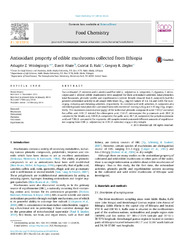Antioxidant property of edible mushrooms collected from Ethiopia.
Date
2014-02-13Author
Woldegiorgis, Ashagrie Z.
Abate, Dawit
Haki, Gulelat D.
Ziegler, Gregory R.
Metadata
Show full item recordAbstract
Two cultivated (P. ostreatus and L. edodes) and five wild (L. sulphureus, A. campestris, T. clypeatus, T. micro-carpus and T. letestui) edible mushrooms were analyzed for their antioxidant activities, total phenolics, total flavonoids, phenolic profile and ergothioneine content. Results showed that A. campestris had the greatest antioxidant activity in all assays with lower EC50 (mg/ml) values of 1.4, 3.6 and 0.035 for scavenging, reducing and chelating activities, respectively. To correlate well with activities, A. campestris also exhibited greater total phenolics and total flavonoids content of 14.6 mg GAE/g and 1.97 mg CE/g, respectively. The maximum concentration (lg/g) of the individual phenolic compounds were 7.80 (P. ostreatus) for caffeic acid, 4.55 (T. letestui) for chlorogenic acid, 15.8 (T. microcarpus) for p-coumaric acid, 20.3 (A. campestris) for ferulic acid, 561.9 (A. campestris) for gallic acid, 38.7 (A. campestris) for p-hydroxybenzoic acid and 7.08 (A. campestris) for myricetin. All samples tested contained different amounts of ergothioneine ranging from 0.08 (L. sulphureus) to 3.78 (P. ostreatus) mg/g in dry weight.
Collections
- Reseach articles [146]

